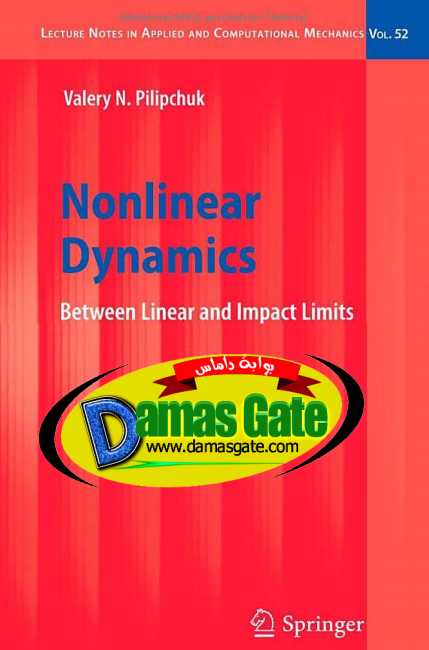Nonlinear Dynamics Between Linear and Impact Limits

Preface
The main objective of this book is to introduce a unified physical basis
for analyses of vibrations with essentially unharmonic, non-smooth or may
be discontinuous time shapes. It is known that possible transitions to nonsmooth
limits can make investigations especially difficult. This is due to the
fact that the dynamic methods were originally developed within the paradigm
of smooth motions based on the classical theory of differential equations.
From the physical standpoint, these represent low-energy approaches to modeling
dynamical systems. Although the impact dynamics has also quite a long
pre-history, any kind of non-smooth behavior is often viewed as an exemption
rather than a rule. Similarly, the classical theory of differential equations usually
avoids non-differentiable and discontinuous functions. To-date, however,
many theoretical and applied areas cover high-energy phenomena accompanied
by strongly non-linear spatio-temporal behaviors making the classical
smooth methods inefficient in many cases. For instance, such phenomena
occur when dealing with dynamical systems under constraint conditions,
friction-induced vibrations, structural damages due to cracks, liquid sloshing
impacts, and numerous problems of nonlinear physics. Similarly to the wellknown
analogy between mechanical and electrical harmonic oscillators, some
electronic instruments include so-called Schmitt trigger circuits generating
nonsmooth signals whose temporal shapes resemble mechanical vibro-impact
processes. In many such cases, it is still possible to adapt different smooth
methods of the dynamic analyses through strongly non-linear algebraic manipulations
with state vectors or by splitting the phase space into multiple
domains based on the system specifics. As a result, the related formulations
are often reduced to discrete mappings in a wide range of the dynamics from
periodic to stochastic. Possible alternatives to such approaches can be built
on generating models developing essentially nonlinear/unharmonic behaviors
as their inherent properties. Such models must be general and simple enough
in order to play the role of physical basis. As shown in this book, new generating
systems can be found by intentionally imposing the ‘worst case scenario’
on conventional methods in anticipation that failure of one asymptotic may
Download
http://s18.alxa.net/s18/srvs2/02/001...act.Limits.rar

Preface
The main objective of this book is to introduce a unified physical basis
for analyses of vibrations with essentially unharmonic, non-smooth or may
be discontinuous time shapes. It is known that possible transitions to nonsmooth
limits can make investigations especially difficult. This is due to the
fact that the dynamic methods were originally developed within the paradigm
of smooth motions based on the classical theory of differential equations.
From the physical standpoint, these represent low-energy approaches to modeling
dynamical systems. Although the impact dynamics has also quite a long
pre-history, any kind of non-smooth behavior is often viewed as an exemption
rather than a rule. Similarly, the classical theory of differential equations usually
avoids non-differentiable and discontinuous functions. To-date, however,
many theoretical and applied areas cover high-energy phenomena accompanied
by strongly non-linear spatio-temporal behaviors making the classical
smooth methods inefficient in many cases. For instance, such phenomena
occur when dealing with dynamical systems under constraint conditions,
friction-induced vibrations, structural damages due to cracks, liquid sloshing
impacts, and numerous problems of nonlinear physics. Similarly to the wellknown
analogy between mechanical and electrical harmonic oscillators, some
electronic instruments include so-called Schmitt trigger circuits generating
nonsmooth signals whose temporal shapes resemble mechanical vibro-impact
processes. In many such cases, it is still possible to adapt different smooth
methods of the dynamic analyses through strongly non-linear algebraic manipulations
with state vectors or by splitting the phase space into multiple
domains based on the system specifics. As a result, the related formulations
are often reduced to discrete mappings in a wide range of the dynamics from
periodic to stochastic. Possible alternatives to such approaches can be built
on generating models developing essentially nonlinear/unharmonic behaviors
as their inherent properties. Such models must be general and simple enough
in order to play the role of physical basis. As shown in this book, new generating
systems can be found by intentionally imposing the ‘worst case scenario’
on conventional methods in anticipation that failure of one asymptotic may
Download
http://s18.alxa.net/s18/srvs2/02/001...act.Limits.rar